
The Future Of Sexuality
(cross posted from my personal blog)
Sexuality In The Past
Sexuality in the Anglo and European West for some recent previous generations was a simple affair. In the Victorian worldview, when categorising things was the preoccupation, the population was divided into two categories, men and women. If a person (a subject), founds themselves to be in the category “man”, then their sexual and romantic desires were felt towards someone from the other category: women (the object of desire). The same is true in the exact reverse for people in the category “women”. If the subject was a woman, their object of desire was a man. Simple.

There was, however, a certain Victorian consciousness of male subjects who desired other men as their sexual objects. This phenomenon was considered ‘deviant’, the result of some sort of mistake. The specifics of who was at fault and what to do about the problem make an interesting study in themselves but are not relevant for our purposes.

I strongly suspect the Victorians found men desiring men upsetting. Part of this upset was to do with the notion that it violated categories. They believed their categories to be “natural”, part of a higher order. The order was ordained by Science, if not by God. When strange anomalies occured to upset the “natural order”, they found them threatening, not least because these anomalies could seriously bugger up their nice diagram.
This uneasiness over categories is very pertinent. It is an emotional reaction to the perceived threat to a structure which is supposed to be neat, perfect, correct and inviolable. Structures (or categorisations) are only emotionally reassuring, only comforting, if they can rely on claims of (near) absolute Truth, solidity, precision and certainty.
If there are persons or behaviours that call into question the completeness of a category structure, or even the entire structure itself, this is so emotionally unsettling that something must be done to shore up the primacy of the system. If such persons or behaviours are in a clear majority, then the structure needs to be recreated. However, if these anomalies are in a minority it is tempting and common to try to eliminate the inconsistency. In this way persons who are privately having sex with whomever they wish without really thinking about it can come to be perceived as a threat to an entire structure of categorisation and sometimes, because structures rely on other structures, a threat to an entire nation’s public behaviour code, civil liberties, laws and moral fibre.
Sexuality is one such category, and we are still struggling to categorise it correctly today. We are required to continue wrestling with categories because we still live in a world based mostly on inviolable structures to which we turn on questions about laws, public behaviour, civil rights and so on.
Sexuality In The Recent Past
The civil rights movement of the 1960s-80s sought to redraw the category diagrams. In terms of sexuality, it is now a very well-known story of improving “gay rights” in the public realm, triggered by the Stonewall riots and onwards through many milestones. One of the milestones that shows us that the movement has been successful is the achievement of same-sex marriage. Same-sex couples can thus access an array of civil and social privileges that they were previously excluded from.
The new acceptable categories can now be described thus: a male subject usually desires a female object, but sometimes, less commonly, a male subject may desire another male as their object. The same is true in reverse. A female subject typically experiences desire for a male object, but sometimes, less commonly, a female object. There are two new categories, “heterosexual” and “homosexual” that apply equally to men and women. The categories look quite nice again now, with a lovely symmetry down the middle.


I couldn’t decide which diagram to include, so here are both.
Sexuality Now
In recent years the “homo” half of the diagram has begun to use the acronym LGBT(Q), standing for Lesbian, Gay, Bisexual, Transgender and (Queer). This is an attempt to recognise that lesbians and gay men are not the only people who are “not straight”. Each time a movement arises to point out that there are more groups within in the “not straight” space, a new letter is added to the acronym. LGBT is currently an accepted basic standard.
At the moment there is a lot of activism and discontent around the lip-service adoption of the B and T letters because most organisations fail to actually provide meaningful services for, or inclusion of, bisexual and trans people. These categories have been very grudgingly added to the diagram.
This unease exists because these two groups “upset the diagram” once again. The bisexual movement currently suffers from erasure, while the trans movement is not actually about sexuality at all. None the less, I will argue that the (much younger) trans movement has been more successful than the bisexual movement to gain recognition.
Gender
The trans movement has recently come to prominence as a group of people who experience something unusual about their gender. Both feminists and trans people have come up with a language to speak about the difference between biological gender, known as sex, and the social construct of gender i.e. the way people are expected to behave or “perform” in social life which is based on their sex but not necessarily inherent in it.
The trans movement has pointed out that it is possible to have gender dysphoria, which means extreme anxiety relating to sex and gender. In the most clear-cut of cases some people are born strongly feeling that they are biologically one sex, but their body appears to have most or all of the characteristics of the other sex. This is detectable at a very young age, often pre-puberty. The feeling of mismatch is so strong that people with dysphoria are more likely to be depressed and some may take their own lives.
Recent campaigns for the rights of trans people have become quickly prominent and successful. Some Anglo-Euro nations have begun to sanction via state benefit the hormonal and surgical treatments for trans people to “transition” from one sex to the other, whereupon the symptoms of gender dysphoria can be eased.
Trans people still suffer from terrible social treatment (not least a very high chance of being murdered for appearing to be gender-nonconforming) however I think the success of the trans movement in civil/legal terms has been partly due to the fact that this revelation about trans-ness has not upset the category diagram too badly. Now we have a small minority who would like to switch from the known categories of “man” and “woman”.

Being trans is an issue to do with sex/gender, rather than sexuality. It is orthoganal to the goals of the diagram but, happily it does not disrupt it too much. Apart from the switch between categories, transmen and transwomen still have a subjective sex/gender and still identify their sexuality according to the sex of themselves in relation to the sex of their object of desire.
Background Bisexuals
The bisexual movement has existed for as long as the “gay” civil rights movement. Indeed in the early days there was little differentiation between gay and bisexual because the issue at hand was same-sex relationships and legal rights. However the bisexual worldview has been sidelined because it is hard to understand, hard to lobby for, appears to “muddy the water” of essentialist messages of what it is like to be gay and people who are willing to identify as bisexual keep going in and out of existence.
Therefore, the bisexual (and intersex, asexual and other “queer”) thoughtforms and practices have been dropped from the public gay agenda for being too confusing. These priorities and people have been erased from gay awareness.
So while organisations now label themselves LGBT, the B in particular is almost universally ignored. I believe this is because bisexuality upsets far too many assumptions about how to categorise people and sexualities.
Here is my attempt to include bisexuality on the diagram:
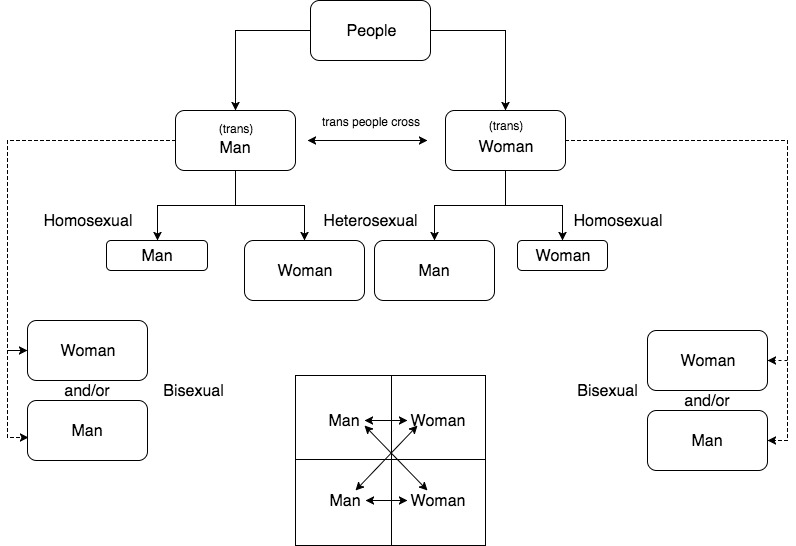
I added the grid to make it more confusing
Bisexual people occupy both sides of the diagram, because they can be a man or a woman, and then they have all these extra labels because they can desire either a man or a woman, or a man and a woman! That pesky and/or causes quite a lot of confusion. This spread across the diagram even calls into question whether the genders of either the subject or the object matter at all, which is the very foundation of the diagram!
Bisexual people have no place to be, a third wheel in the hetero/homo binary, excluded from both groups depending on the gender of their current partner, but still not included even if their partner is a match. Bisexuals are treated with suspicion because they seem to violate the purity boundary between gay and straight. Bisexual people themselves flip-flop between “being” gay and straight because being “half” anything never worked.
Studies of sexuality exclude bisexual people for ‘throwing off’ the results. Many straight scientists call the sexuality “indeterminate” and gay and lesbian people call it “on the fence” and “halfway out”.
Bisexual people also tend to come out at a much older age than straight or gay people, partly because many people experience their sexuality as something that changes over time, rather than as something essential they were born with, or that happened to them growing up as a child that they can’t control. This notion has been the cornerstone of gay rights, and to think that one has any control over their sexuality, or that it can change, is taboo.
Most people who have bisexual feelings take care to not identify with this reviled label, thus creating the illusion that this sexuality is a tiny minority, which is good for everyone else because bisexuality is so upsetting to the diagram that it cannot be tolerated.
(NB: if you unscientifically read between the lines of other data sets and hang out in bisexual activism circles, it seems clear that at least 40% of the population have behaved in a bisexual way in their lifetimes).
Straight and Queer
It has become increasingly common recently for the LGBTQI+ community to ditch all the letters, because they are becoming quite a mess, and adopt a former slur “queer” as an umbrella term to easily point to “not straight”. This umbrella has the advantage of pointing to a fairly large group (up to 20%) of the population while being non-specific about what it means, other than it’s in the gender & sexuality mess space. In this way it can encompass all the pesky extra weirdos with just one term, and reinstate the precious binary.
This is an opportunity for another way to organise the diagram.
The “queer” side is still just lesbian and gay, with its perfect symmetry of straight, but we’ve added the other weirdos (trans and bi) on the side. While these people apparently make up a minority, it still makes the categorisations looks awkward.
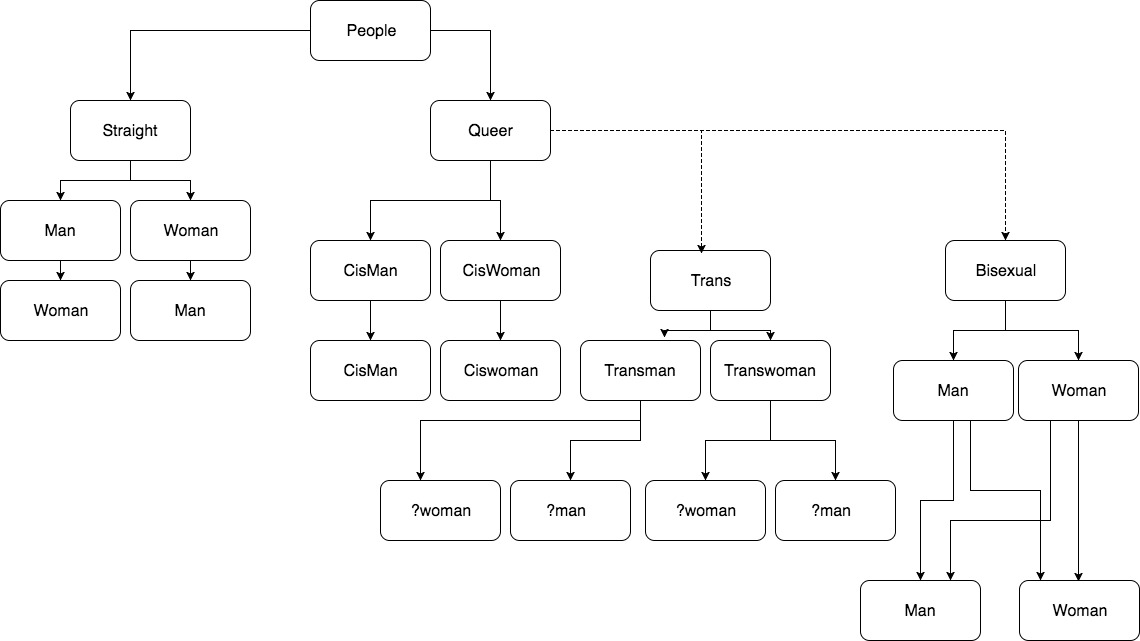
Intersex, Questioning and Asexual need to go on the right but I ran out of space
This straight/queer grouping is supposed to be reassuring and it has worked for a while (for straight/gay people) but it seems like an unsatisfactory way to “contain” all the “mess” of people who are not-straight.
On the other hand, bi people flock to the word “queer” if not the community. More on that below.
However, this is not the only possible taxonomy.
Bisexual and Monosexual
I’m going to let you into a secret of the bisexual community, when those communities have enough structural momentum to temporarily coagulate. Bisexual people sometimes use an alternative binary to describe the world. It consists of Monosexuals (60%): those who are attracted to only one gender and Bisexuals (40%): those who are attracted to more than one gender. When bisexuals are prominent as a category, rather than treated as an enormous “anomaly”, a very different diagram appears.

This representation gets closer to the world from a bisexual point of view. The gender of the subject is completely dropped from bisexuals in this worldview, because the label would say “man or woman” attracted to “man and woman”, which is pretty pointless. In the bisexual world, the diagram is not based on the gender of subject and object. So it also doesn’t matter if you are trans, or if your object of desire is trans.
“Monosexual” is the label for those strange people who insist on gender being the ultimate factor for sexual subjects and objects, and “Bisexual” is for those who do not. Monosexual people can still be trans, and I am remiss for not including it back on the diagram. At any rate they fit ok in the monosexual categories too.
How successful is this model? In my experience, people who are not bisexual, and even those who disagree strongly with bisexuals, tend to congregate in bisexual spaces. These include trans, intersex, agender, asexual and neuro-atypical people, as well as straight and gay of course. The true “umbrella” queer world, in my view, is the bisexual space, because everyone can fit there, with no dogma on gender or sexuality that fundamentally rejects what they feel inside.
Breakdown
At this point the actual word “bisexual” is simply meaningless. It originally meant “two” sexes and now the bisexual community defines it as “more than one”, in opposition to monosexuals, who only like one. But if gender is not really in the picture any more, why are we using these terms to define sexuality? Some activists have tendered the word “multisexual” as the opposite of monosexual, however this has largely failed. It has failed because using the idea of gender to define sexuality is pointless to bisexual people. This binary of bisexual/monosexual is unstable, and contains the seeds of its own destruction.
If not bisexual, then what? While ‘monosexual’ still seems somewhat descriptive for those with single-gender tastes, we have no good name for everyone else. The diagram is not based on gender, so the meaning of the words is dissovling before our eyes. The bisexual label has disappeared, with just a gap in its place. This is why so many bi people say “I’m just me” when asked to identify their sexuality. The question of their sexuality is mu. The true answer is outside of the frame of the question.
(I will, however, continue using “bisexual” for this article for lack of any other good word.)
I believe if we take the implications of the bi/mono model to their logical conclusion, if we run headlong into the black hole, we can finally dissolve or explode our categories of sexuality altogether. We can find new ways of making meaning about this attribute: sexuality.
Let’s explode
The danger of spectrums
When seeking new ways to define sexuality, it will be tempting to describe attributes as “spectrums”. Let’s take gender as an example. We have already said that bisexuality removes gender from the concerns of sexuality. However, most people do have some preferences when it comes to gender.
Two scientists have so far tried to classify bisexual preferences. Kinsey designed a spectrum (with numbers 1-6). Number 1 means those who are exclusively heterosexual and number 6 means those who are exclusively homosexual, with number three meaning you are equally attracted to men and women. This spectrum is sort of useful but has many problems.
One problem is that this Kinsey number changes as soon as you modify any part of the question. The dimensions of time (past, present and future), fantasy, sex drive and levels of opportunity all play a huge role in how one’s attractions can be rated on the scale.
In comes the Klein grid, attempting to make sense of these different desires, where you rate your Kinsey number for fantasy, the past, the present etc. and end up with a grid of different numbers. This is quite fun at first, however as their own website shows, this taxonomy soon dissolves into nonsense. As I’ve written before, these are well-intentioned attempts at eternalising an inherently nebulous thing.
The truth is, sexuality is nebulous and refuses to be pinned down by number scales. Level of attraction to one gender does not really relate to attraction to another gender along a sliding scale. They are not even on the same scale! Placing an apparent binary at opposite ends of a single scale is a mistake. It is still within the old gender binary way of thinking.
Factors, influences, preferences
It is easier to say that gender is a factor, but one with as variable importance as any other number of attractiveness factors, such as: body shape, eye colour and social status. It is perfectly possible to find both blue eyes and brown eyes attractive and to prefer blue eyes does not say anything at all about how much one likes brown eyes. These are all just factors of attraction.
Now that we are looking for factors of attraction, the landscape becomes clearer. Factors of attraction in the object of desire can be physical attributes, mental attributes and social attributes. There are also a number of factors relating to the subject experiencing attraction too. One’s age, sex drive, hormone balance, sexual practices and turn-ons are all big factors in attraction.
Cruicially, one lesson from the bisexual world is that preferences can change. It is not threatening to think that one used to prefer blondes but now like brunettes, but it is currently taboo to say that one used to prefer women and now finds men attractive too. The essentialist argument was important for gay rights, but now it is damaging all of us by impying that sexuality can never change. When we acknowledge change, our various identity labels can change too, with much less harm than is caused now.
When thinking about all of these preferences and factors, common configurations emerge. The queer world has been making headway inventing names to refer to these clusters of attributes, such as: femme, boi, bear, butch, cub, twink, unicorn. The straight world has far fewer words, but they exist, such as ‘cougar’, even if they do get ruined (‘sapiosexual’ anyone?) However there could be much greater mileage in identifying and naming these common configurations.
Gender will very much still be in there, since not-trans straight people are still the most common. These days one ticks some boxes on dating sites e.g ‘male’ looking for ‘female’ and this new model would be just as simple. Non-transgender people are known as cisgender and most people are straight, or heterosexual. ‘Cishet’ is the word for the common configuration of “cisgender” and “heterosexual”. It is already commonly used in the queer world. So now you might tick the box ‘cishet’ looking for ‘femme’. Simple.
None of this is new. Dating sites have been trying to capture these preferences with more or less success for decades. I simply believe that our conceptual models, which are exclusively based on gender, are holding us back from realising the broad potential of sexuality.
Sexuality In The Future
Given the avenues of thought provided by Bisexuality, the future of sexuality could be very different. Rather than see sexuality as a biological binary because it depends on the biological “binary” of gender, sexuality can be seen as a personal attribute with both biological and cultural components that is affected by many factors.
Like other human attributes a person’s sexuality is both enduring and also evolves over time. It features many strands of influence, some biological, some social. Most of these strands are context-specific, some occur all the time. Some strands of attraction relate to the subject of desire and some strands relate to the object of desire. Some refer to social context, some are factors totally outside of our control, while some strands can be readily changed by new interactions or even conscious effort.
Many of these strands commonly appear together and so colloquial labels will continue to grow up around these clusters to make it easier to describe oneself and who one desires, but these labels should be seen as flexible, incomplete and eventually, obviously, they will go out of date.
In this model, changing one’s own gender, or changing which genders one is attracted to is unproblematic, just as liking blondes or brunettes is unproblematic now.
Some scales apart from gender seem obviously very useful, such as sex drive. Some people have no sexual desire at all, and some people prefer to have sex every day. Surely matching with a person on sex drive is just as important as on gender (if you’re monogamous). The ways that age can interact with sex drive seems very interesting. Should we be encouraging more sex between older women and younger men, for example?
What other scales and dimensions come into play with sexuality?
New Diagrams
I think some of the current ways of thinking about sexuality are still useful when providing a simple model for people who need that. Much like high school physics, we could present a simpler model to high schoolers that is oversimplified. Then, just as with physics undergrads, the more complex model can be revealed when the person is cognitively ready for it. Perhaps in high school we will still use this diagram:
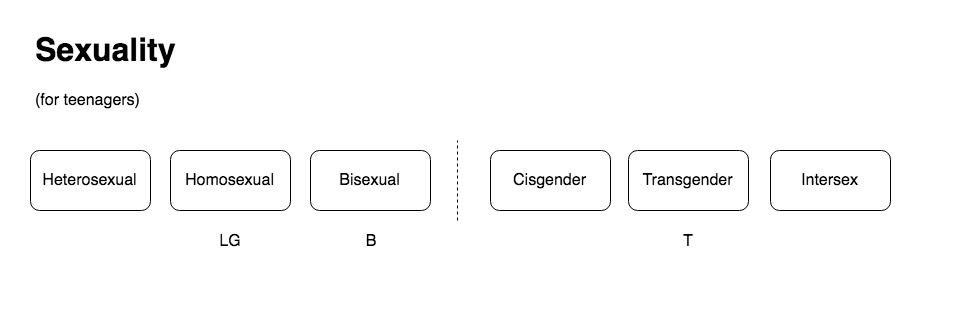
and for those who are cognitively ready it will look more like this, a many-stranded colourful cluster of changeable attributes and preferences:
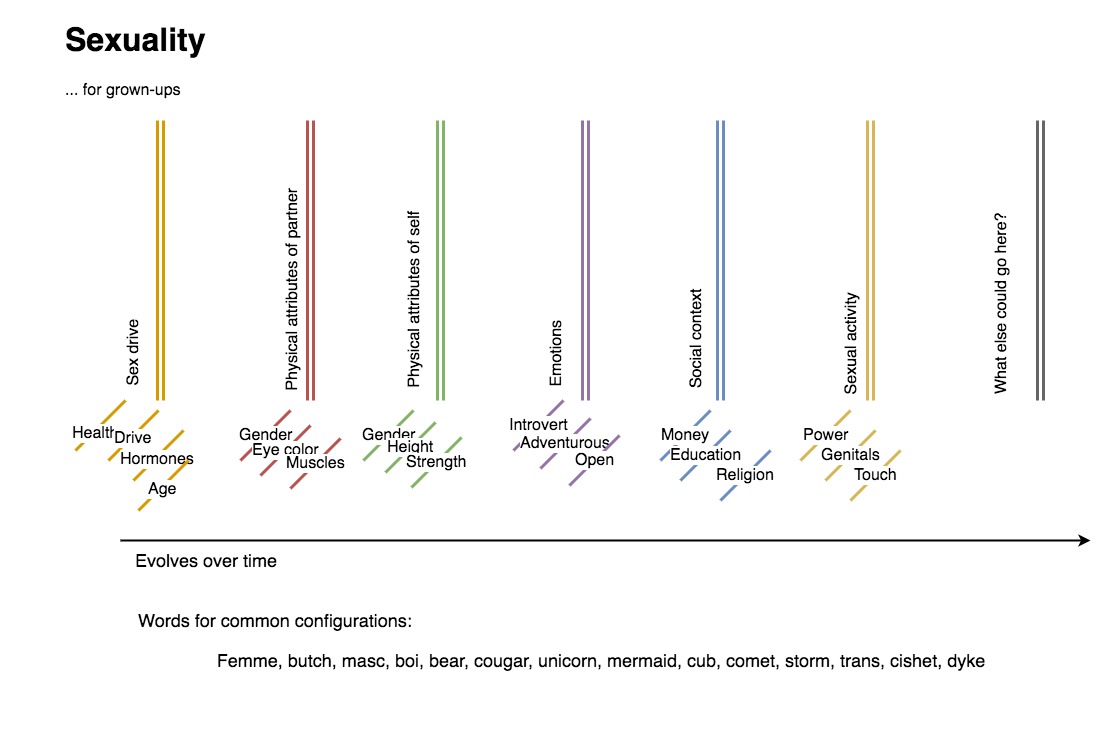
I imagine this to be like colourful strings of yarn, and there would be hundreds of strands all dangling before us. Each person can grab lots of strings, and grab different ones on different days. A certain group of strings might have a label that describes it, and one’s own fistful might be quite similar to the label, but each person’s fistful o’ yarn will also be unique. This diagram does not have hundreds of strings, but you get the idea.
I think that if we adopt this way of approaching sexuality, our conceptions of it can go from this:

to this:
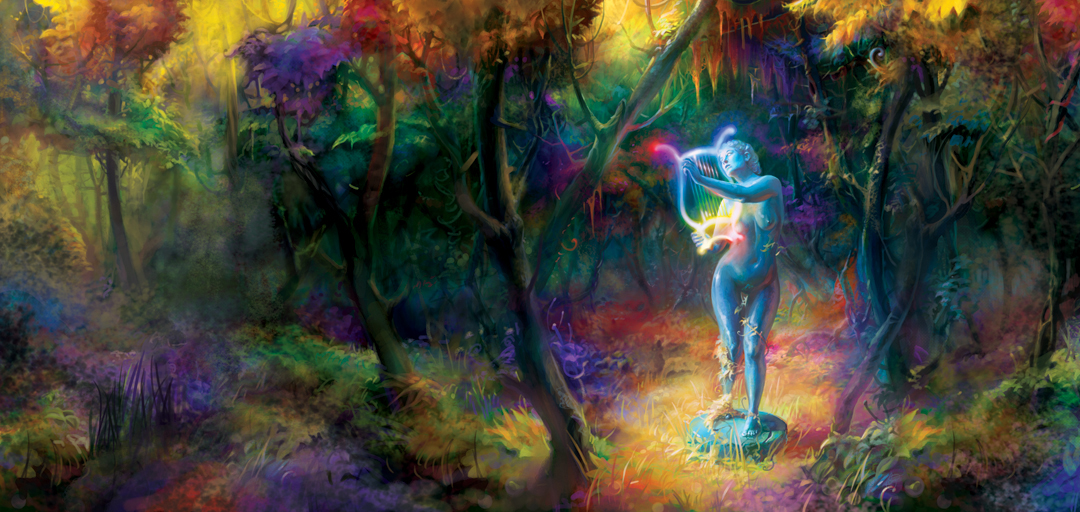
Rainbow Harp! Image by Sheppard Arts
…without too much hardship. Looks like fun!
Conclusion
Sexuality and gender don’t belong in boxes forever, and it’s not too hard to think outside them. We can conceptualise sexuality as a personal attribute that depends on many factors and evolves over time. We may simplify this for those who need it, but the complex model should underpin adult life.
Also:
- Diagrams are harder to make than they look.
- Bi people are fun! You should hang out at their parties.
- I got the inspiration for this blog post from a strangely coherent dream.
Post Script
I did not realise when I started this post that I am proposing the end as we know it of sexuality labels and ditching LGBT. By the end of this post I realised that’s exactly what I’m doing. While this is scary, I think it may actually be the right time. The straight /L / G project has been pretty successful. There’s very little left to do. In order to achieve the goals of B, a turning-inside-out of assumptions has to happen. As a bi activist, I started to realise that, rather than berate people for not identifying as bi (which causes sooo many organisational problems), or berate others for being so prejudiced towards “b” that no-one will identify as it, I decided I should accept how others feel and behave, understand why, and work with it. Work to push it further in its own direction, rather than force it into boxes. This might be one way of doing that? I’m not certain. As I said, I woke up from a dream with this all in my head, you can let me know if it makes any sense.
Very helpful for me, actually. I’ve been frustrated with the lack of sane discussion about testosterone and with the stignatization, shaming, and double standard that has accompanied discussions of traditionally male sexual behavior in the nonetheless necessary metoo era. So much so that I have been driven back into the arms of more traditional thinking on the subject as a way of staying and feeling safe as a (so far) traditional “man” reared in a rural area. I’ve finally been getting to more nuance in the past few weeks and returning to my longer term feminist and ‘sexuality for grownups’ tendencies (at least in thought) the past month. The chart that shows a clean, simple categorization of bisexuality on one side, and places the “mess” of mono on the other side, was extremely helpful. All sorts of biological and social factors influence who one is attracted to, yet to think of attraction in such clean, equal terms is deeply satisfying. People are just people. They connect, support, and fuck each other. Further boxes than that as a largely immature way of placing behaviorAL expectations on others that don’t matter for social functioning and could in fact be counterproductive on people. Going to be chewing on that one for awhile.